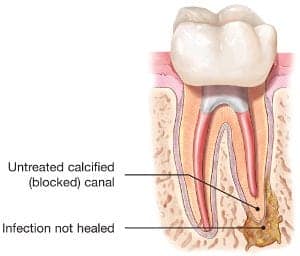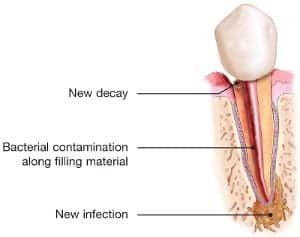
ROOT CANAL
RE-TREATMENT
If your previous root canal has failed to heal or has developed new problems, another root canal procedure, called a Re-treatment or Re-root canal, allows you a second chance at saving your tooth.
What is Root Canal Re-Treatment?
Root canal treatment has an extremely high success rate of 90-95%. Occasionally, root canal treatment fails to heal or the pain continues.
This can happen few weeks or even years after successful
treatment.
If your previous root canal has failed to heal or has developed new problems, another root canal procedure, called a Re-treatment or Re-root canal, allows you a second chance at saving your tooth.
Endodontic re-treatment involves reopening your tooth to clean, sanitize and reshape the chamber and canals in order to save your tooth.
Looking for painless root canal treatment near me? At our clinic, we specialize in providing a comfortable and stress-free experience with advanced techniques that minimize discomfort. Our dedicated team focuses on ensuring your procedure is as smooth and pain-free as possible, so you can leave with a healthier smile and peace of mind.
Best Option? Save your natural teeth
Why choose us for Root Canal Re-Treatment?
Retreatment is usually more challenging, so many dentists refer patients needing retreatment to endodontists (Root canal specialists).
Endodontists have three additional years of training after graduation in order to specialize in the treatment of tooth pain and root canals. No one is more qualified to perform these procedures than an endodontist.
The head dentist at Dentaris – Dr. Nihar Thakkar is an endodontist, so you can feel confident knowing you are getting the best possible care.
We take the time to thoroughly assess the risk factors in every case. When needed, we use 3D imaging (CBCT scans) & dental microscope to evaluate and determine the best treatment option for your specific needs.
When will a tooth require root canal re-treatment?
Re-treatment is required when the previous root canal treatment fails.
Root canals usually fail when the original treatment does not remove all the infection or the tooth becomes
infected again.
Sometimes, it is possible that your tooth won’t heal as expected even after properly done root canal
treatment.
What are the reasons for failed root canal treatment?
This could be because of a variety of reasons, including:
- Narrow or curved canals were not treated during the initial procedure.
- Complicated canal anatomy went undetected in the first procedure.
- The placement of the crown or other restoration was delayed following the root canal treatment.

A new problem can also put a successfully treated tooth at risk, such as:
- New decay can expose the root canal filling material to bacteria, causing a new infection in the tooth.
- A loose, cracked or broken crown or filling can expose the tooth to new infection


How to recognize if you need re-treatment?
Some patients show no symptoms of a failed root canal, while others’ symptoms may look different than they did before the first root canal. You may recognize the symptoms of infection, such as pain in the root canal treated tooth, pimples on the gum or swelling.
Because root canal failure can sometimes be hard to see with the naked eyes, X-rays can help us diagnose and treat a failed root canal.
How to recognize if you need
re-treatment?

Some patients show no symptoms of a failed root canal, while others’ symptoms may look different than they did before the first root canal. You may recognize the symptoms of infection, such as pain in the root canal treated tooth, pimples on the gum or swelling.
Because root canal failure can sometimes be hard to see with the naked eyes, X-rays can help us diagnose and treat a failed root canal.
Patients who have had their root canal treatment done at our dental clinic are often pleasantly surprised with the level of comfort they experience during their appointment
What are the symptoms of a failed root canal that would require re-treatment?

- Pain from pressure on the tooth with previous root canal
- treatment
- Spontaneous pain in the tooth with root canal treatment
- A pimple or boil on the gums near the affected tooth
- Tenderness and/or swelling on the gums of the root canal
- treated tooth
- Swelling near the affected tooth
- Swelling on the face

What is the success rate of retreatment?
The success rate of retreatment or re-root canal procedure is similar to that of the original root canal but slightly lower. It ranges from 80% to 88%. Following your dentist’s instructions after the procedure helps to reduce your risk of failure.
HOW IS ROOT CANAL RE-TREATMENT DIFFERENT FROM ROUTINE ROOT CANAL TREATMENT?
- Pain from pressure on the tooth with previous root canal
- treatment
- Spontaneous pain in the tooth with root canal treatment
- A pimple or boil on the gums near the affected tooth
- Tenderness and/or swelling on the gums of the root canal
- treated tooth
- Swelling near the affected tooth
- Swelling on the face
What are Alternatives to Root Canal Retreatment?
Treatment options will vary depending on the severity of the infection & the amount of intact tooth structure that is left.
1) Endodontic surgery – Apicoectomy (Root end resection)
This surgery involves making an incision to allow access to the tip of the root. Endodontic surgery may also be recommended in conjunction with retreatment or as an alternative.
2) Extraction
Many times, the extracted tooth must then be replaced with an
- Implant
- Bridge or
- Removable partial denture
No matter how effective tooth replacements are – nothing is as good as your own natural tooth. The payoff for choosing retreatment could be a healthy, functioning natural tooth for many years to come.
Just like root canal treatment, endodontic re-treatment involves opening your tooth to clean, sanitize and reshape the chamber and canals in order to save your tooth.
However, re-treatment has a few extra steps and usually requires more than two visits.
Additional steps include:
- Removal of previous root canal filling materials
- Management of complications (If any) –
- Finding & cleaning previously undetected root canals
- Opening up narrow and blocked canals
- Bypassing ledges
- Managing broken root canal instruments
- Sealing perforations
- Placement of an antibacterial medicament


